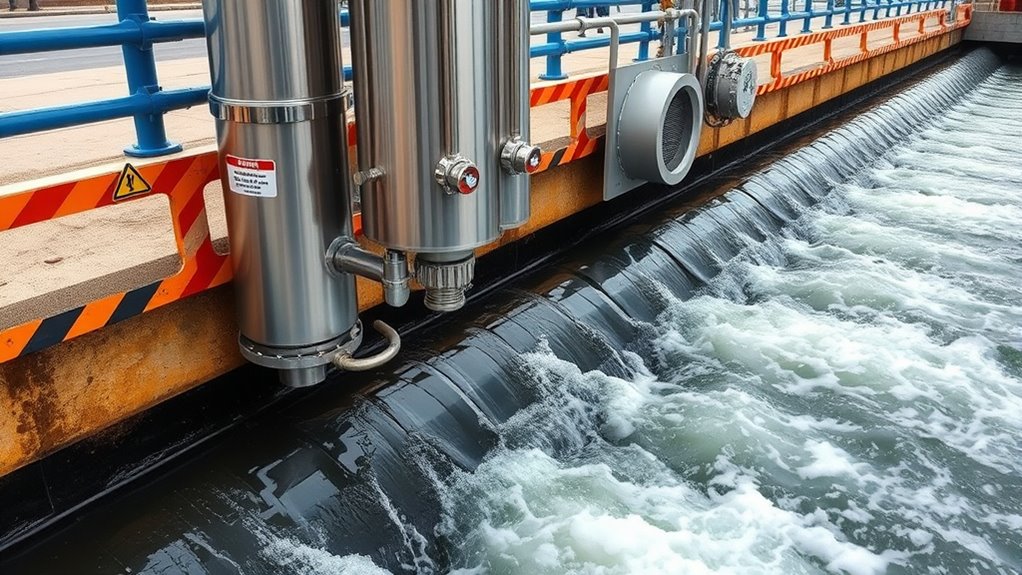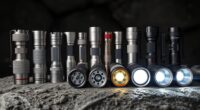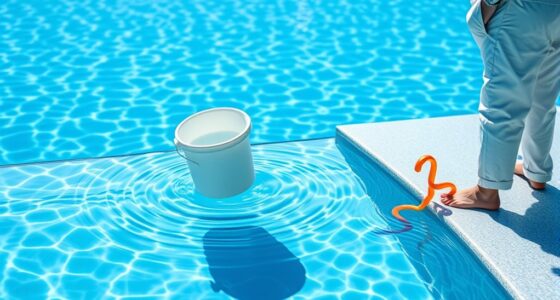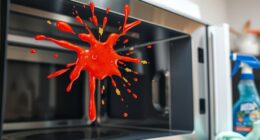To avoid chlorine gas buildup at the weir, make certain your chemical feeders are properly calibrated and maintained regularly. Monitor water chemistry closely, paying attention to pH and chlorine levels, and use gas detectors along with proper ventilation systems. Train staff to recognize warning signs and respond quickly to leaks or dangerous conditions. Consistent safety checks and adherence to best practices help prevent hazardous gas formation—continue exploring methods to keep your system safe and effective.
Key Takeaways
- Regularly calibrate chemical feeders to ensure accurate chlorine dosing and prevent gas buildup.
- Monitor pH and chlorine levels continuously with sensors to detect unsafe conditions early.
- Maintain proper ventilation and install gas detectors around the weir area for early leak detection.
- Inspect and service safety devices, such as alarms and venting systems, regularly to ensure effectiveness.
- Implement staff training and emergency protocols to respond swiftly to potential chlorine gas releases.
Understanding the Risks of Chlorine Gas Formation at the Weir
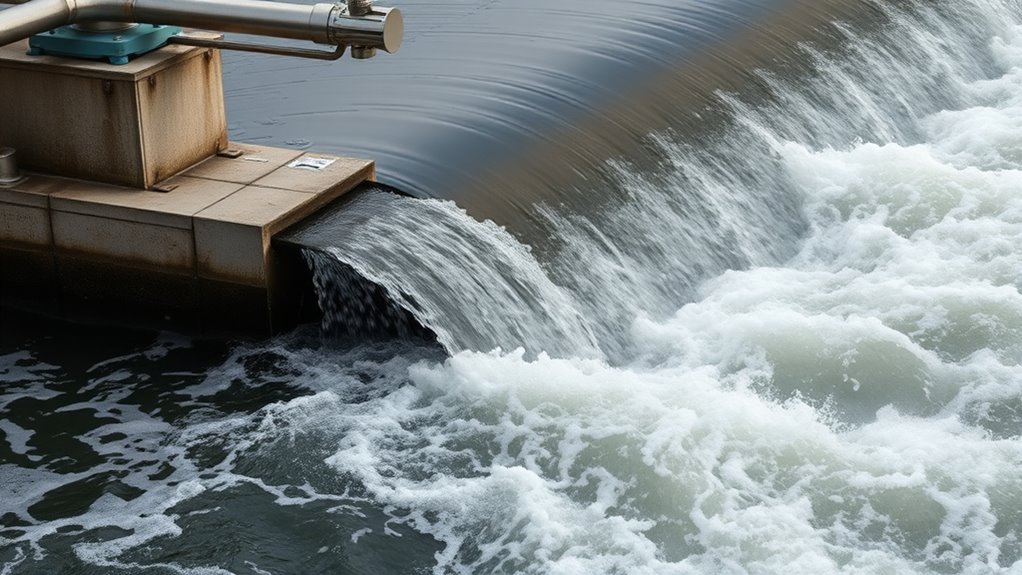
Understanding the risks of chlorine gas formation at the weir is essential for safe chemical feed operations. When chlorine reacts with water, especially in high concentrations, it can produce toxic gases like chlorine vapor. These gases are hazardous to personnel and can cause respiratory issues or even fatalities. The weir area, where chemicals are introduced and mixed, is a critical zone where gas buildup can occur if conditions aren’t properly managed. Factors such as temperature, pH levels, and concentration of chlorine influence gas formation. Without proper awareness and precautions, accidental releases can happen, posing serious safety risks. Monitoring these conditions diligently helps prevent dangerous accumulations of chlorine gas, ensuring a safer working environment and avoiding costly accidents. Additionally, understanding the reaction mechanisms involved in chlorine gas formation can aid in designing more effective safety protocols.
Proper Calibration and Maintenance of Chemical Feeders
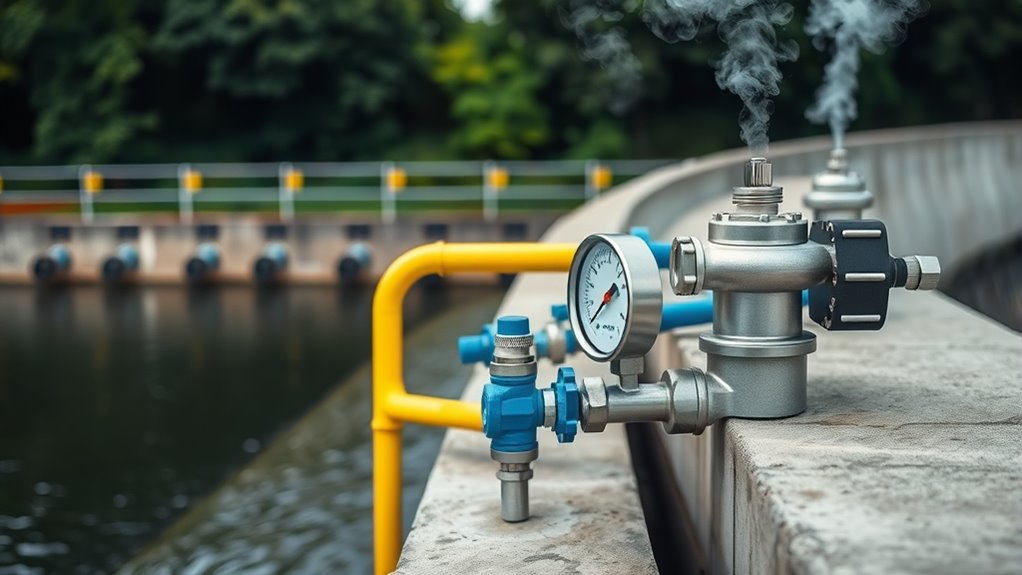
Proper calibration and maintenance of chemical feeders are essential to guarantee accurate chemical dosing and safe operation. Regularly check calibration settings to ensure the correct flow rates, especially when changing chemicals or feed rates. Use manufacturer guidelines and calibrated measurement devices for accuracy. Inspect feed pumps, valves, and tubing frequently for signs of wear, leaks, or blockages. Clean and service components as recommended to prevent buildup that can disrupt dosing precision. Keep detailed maintenance logs to track adjustments and repairs. Proper calibration prevents over- or under-dosing, reducing risks like chlorine gas formation. Accurate chemical delivery is critical for effective water treatment and safety. Consistent maintenance ensures the system functions reliably, minimizing safety hazards and ensuring that chemicals are delivered exactly as needed for effective water treatment.
Monitoring Water Chemistry Near the Weir
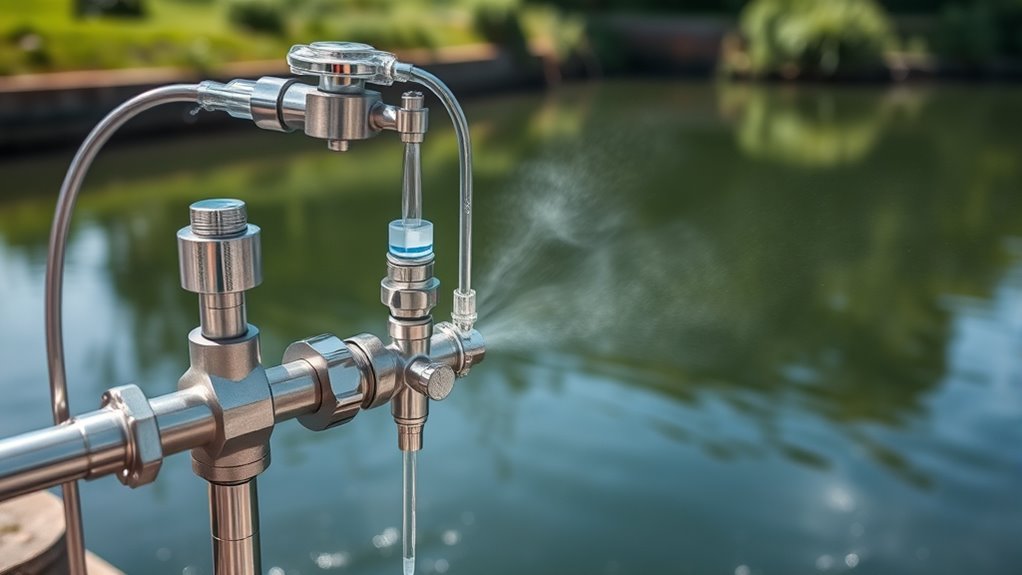
Monitoring water chemistry near the weir helps you catch issues early and maintain ideal flow conditions. Real-time chemical analysis allows you to quickly assess changes in water quality, preventing problems before they escalate. Additionally, keeping an eye out for gas leaks ensures safety and protects equipment from corrosion or damage.
Real-Time Chemical Analysis
Real-time chemical analysis near the weir allows you to quickly detect changes in water chemistry, ensuring ideal treatment and system performance. This continuous monitoring helps prevent issues like chlorine gas buildup or inadequate disinfection. To optimize results, focus on these key aspects: 1. Use advanced sensors that provide real-time data on pH, chlorine levels, and other critical parameters. 2. Implement automated alerts that notify you immediately of any chemical deviations. 3. Regularly calibrate sensors to maintain accuracy and avoid false readings. 4. Incorporate filtration units with HEPA filters to reduce airborne contaminants and safeguard sensor integrity.
Detecting Gas Leaks
Detecting gas leaks near the weir is essential for maintaining safe water treatment operations. Gas leaks, especially chlorine or chloramine, pose health and safety risks. You should regularly monitor the area with gas detectors designed for chemical fumes. These detectors alert you immediately to any leaks, preventing dangerous exposure. Visual inspections are also critical—look for unusual odors, bubbling, or corrosion around chemical feeders. Installing fixed gas detection systems offers continuous monitoring, giving you peace of mind. Keep maintenance logs of detectors and test them often to ensure proper function. Promptly address any alarms or irregularities to minimize hazards. By actively monitoring water chemistry and gas levels, you safeguard your team and ensure the treatment process runs smoothly. Regular water chemistry monitoring helps identify potential issues early and maintain safe operation standards.
Implementing Adequate Ventilation and Gas Detection Systems
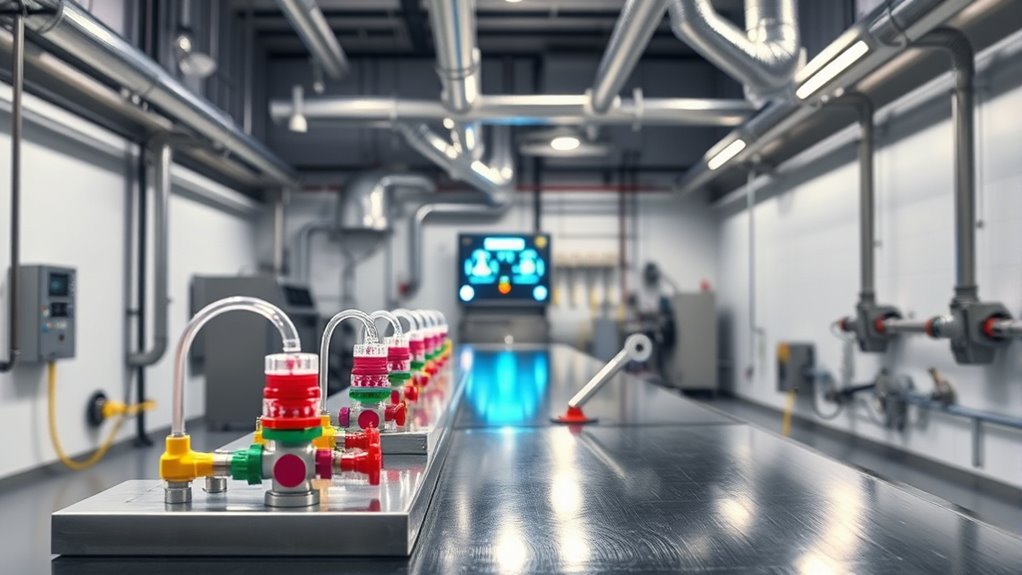
To guarantee safety when handling chemical feed systems, implementing adequate ventilation and gas detection is essential. Proper airflow prevents the buildup of chlorine gas and reduces health risks. Gas detection systems act as early warning tools, alerting you to leaks before they become dangerous. Additionally, ensuring that detection devices are placed in high-risk areas can enhance safety measures and prevent accidents.
Best Practices for Chemical Dosing at Critical Points
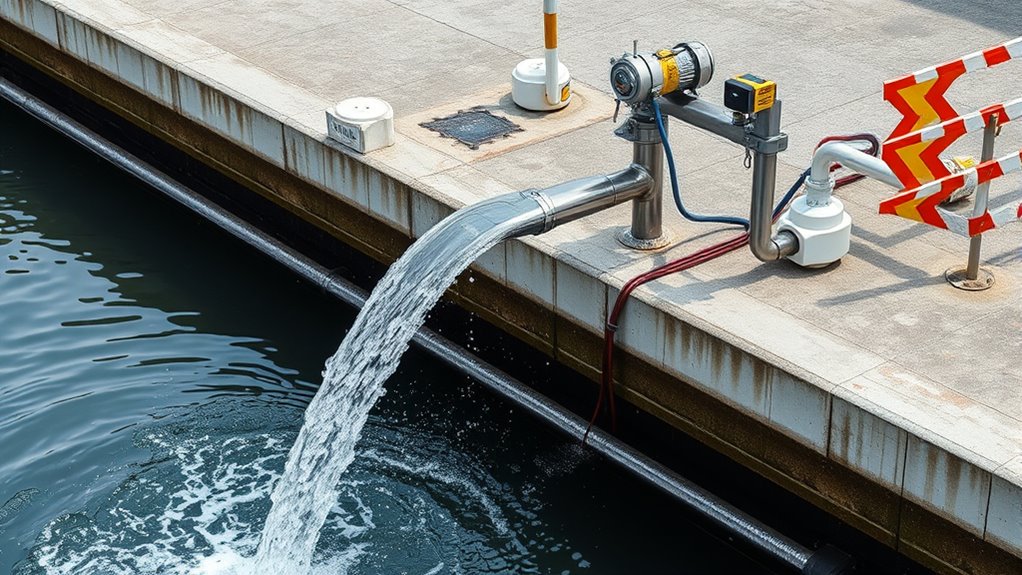
Ensuring accurate chemical dosing at critical points is essential for maintaining system safety and efficiency. To do this, verify that your dosing equipment is properly calibrated regularly, preventing over- or under-dosing. Use reliable flow meters and control valves to maintain consistent chemical delivery. Always monitor feedback from sensors and adjust dosing rates accordingly to match real-time system needs. Maintain clear records of dosing activities and check for leaks or blockages that could compromise accuracy. Implement automatic controls where possible to reduce human error. Keep chemical feed points clean and accessible for inspections. Additionally, consult whole-house system comparisons to ensure your setup is appropriate for your water quality and flow rate. Ultimately, coordinate with your team to review dosing procedures periodically, ensuring best practices are followed and safety is prioritized at every critical point.
Training Staff to Recognize and Respond to Gas Hazards
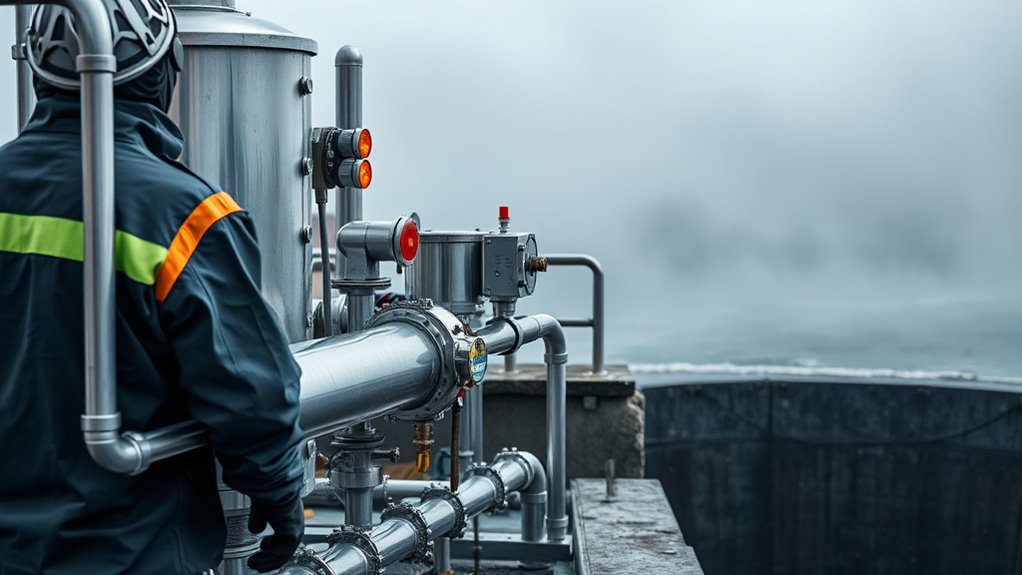
Proper chemical dosing helps prevent hazards, but staff must also be prepared to recognize and respond to gas leaks or exposures promptly. Training your team is essential for quick, effective action. Focus on these key areas:
- Identifying symptoms: Teach staff to recognize signs like eye or throat irritation, coughing, or unusual odors indicating chlorine gas presence.
- Using detection equipment: Ensure they know how to operate gas detectors and interpret alerts correctly.
- Emergency procedures: Train staff to follow immediate steps, such as evacuating the area, activating alarms, and notifying emergency responders.
Regular drills reinforce these skills, helping staff stay alert and confident. Well-trained personnel can prevent injuries and contain hazards before they escalate, safeguarding everyone’s safety.
Regular Safety Audits and Emergency Preparedness
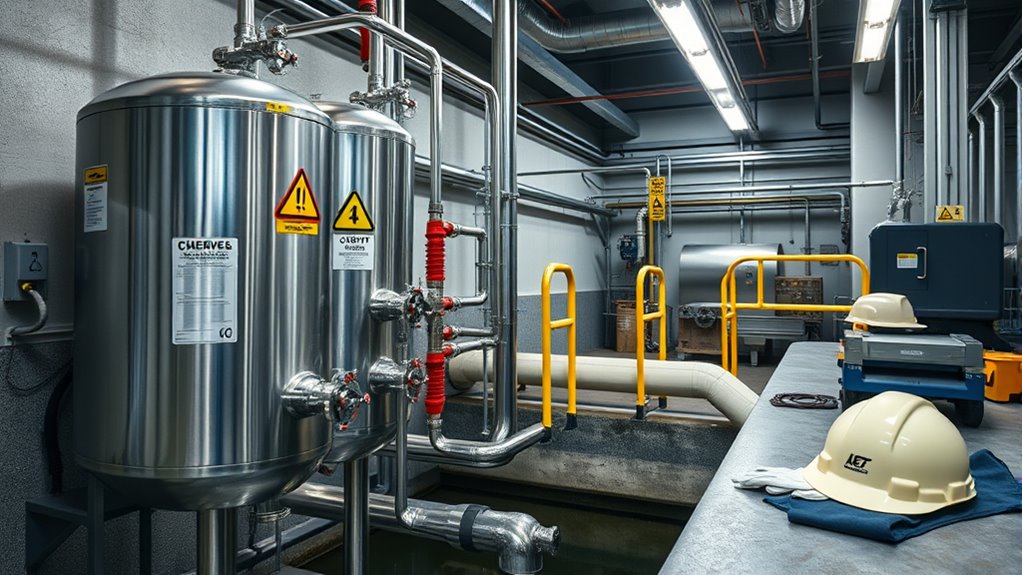
You need to conduct routine safety inspections to spot potential hazards before they become serious. Developing clear emergency response plans guarantees you’re prepared for unexpected incidents. Regular staff training keeps everyone sharp and ready to act quickly if an emergency arises. Incorporating safety-focused craftsmanship in your equipment and procedures can further minimize risks and promote a safer environment.
Conduct Routine Safety Inspections
Regular safety inspections are essential for maintaining safe chemical feed operations, as they help identify potential hazards before they cause problems. During inspections, you should focus on key areas to ensure safety and compliance. First, check for leaks or corrosion in pipes and equipment, which could release hazardous gases. Second, verify that safety devices like alarms and venting systems are functional and properly maintained. Third, inspect storage areas for proper labeling, secure containment, and clearance to prevent accidental releases. Additionally, conducting routine safety audits can help ensure all procedures are followed correctly and standards are met. By systematically reviewing these components, you reduce the risk of chlorine gas leaks and other hazards. Regular inspections keep your operation compliant with safety standards and help you catch issues early, ensuring the safety of personnel and the environment.
Develop Emergency Response Plans
Developing a thorough emergency response plan is essential for ensuring quick and effective action during chemical incidents. You need clear procedures that outline immediate steps, evacuation routes, and communication protocols. Regularly review and update the plan to reflect changes in your facility or processes. Assign specific roles to team members so everyone knows their responsibilities during an emergency. Incorporate safety equipment locations, spill containment measures, and first aid procedures into the plan. Conduct drills to test the plan’s effectiveness and identify areas for improvement. A well-prepared response plan minimizes risks, protects personnel, and reduces environmental impact. Regular training and emergency preparedness exercises help reinforce response strategies and build confidence among staff. Remember, preparation is an ongoing process—staying proactive guarantees you’re ready to handle unexpected chemical incidents efficiently.
Train Staff Regularly
To guarantee your team remains prepared for chemical emergencies, conducting ongoing safety audits and emergency preparedness training is essential. Regular training keeps everyone sharp and aware of proper procedures. To maximize effectiveness, focus on:
- Conducting quarterly safety drills to reinforce response protocols.
- Updating training materials to reflect the latest safety standards and equipment.
- Reviewing incident reports to identify gaps and improve response strategies.
- Incorporating emotional support strategies for staff to manage stress and maintain focus during emergencies.
Frequently Asked Questions
What Are the Most Common Signs of Chlorine Gas Exposure?
You might notice coughing, shortness of breath, or a sore throat if you’re exposed to chlorine gas. You could also experience chest tightness, eye or skin irritation, or nausea. In more severe cases, dizziness, wheezing, or a burning sensation in your lungs may occur. If you suspect exposure, get fresh air immediately and seek medical attention right away to prevent serious health issues.
How Often Should Chemical Feed Systems Be Inspected?
To keep your system running smoothly, you should inspect your chemical feed systems at least monthly. Regular inspections help identify minor issues before they become major problems, ensuring safety and efficiency. Check for leaks, corrosion, and proper calibration. If your system operates under heavy use or in harsh conditions, consider more frequent inspections. Staying proactive minimizes risks, maintains consistent chemical levels, and keeps your facility safe and compliant.
What Safety Equipment Is Essential for Chemical Handling?
You should wear appropriate safety equipment when handling chemicals, including chemical-resistant gloves, goggles or face shields, and long-sleeved clothing to prevent contact. A respiratory mask is essential if there’s a risk of inhaling fumes or gases. Always have a spill kit nearby, and guarantee proper ventilation in the area. Prioritize safety by following manufacturer instructions and your facility’s safety protocols to avoid accidents and exposure.
How Can I Reduce Chlorine Gas Buildup at the Weir?
You can reduce chlorine gas buildup at the weir by optimizing your ventilation system, which can cut gas concentrations by up to 50%. Regularly inspect and maintain your chemical feeders to prevent leaks. Use proper gas detection equipment to monitor levels constantly. Also, consider installing a scrubber system to neutralize chlorine gases immediately. These steps keep your workspace safer and help you stay compliant with safety standards.
Are There Alternative Chemicals to Chlorine That Pose Less Risk?
Yes, you can consider alternatives like bromine, ozone, or potassium permanganate. Bromine is less volatile and safer to handle, while ozone effectively disinfects without forming chlorinated compounds. Potassium permanganate acts as an oxidizer and is useful in specific applications. You should assess your system’s needs and consult safety data sheets to determine which alternative offers the best safety and effectiveness for your process.
Conclusion
By staying vigilant and following these safety practices, you can prevent chlorine gas buildup at the weir. Think of it as safeguarding a precious gem—you wouldn’t risk damaging it. Regular maintenance, proper training, and constant monitoring are your best defenses against hazards. Don’t let complacency be the thief of safety; instead, stay proactive. Because when you prioritize safety, you guarantee smooth operations and protect everyone involved—turning potential danger into peace of mind.
